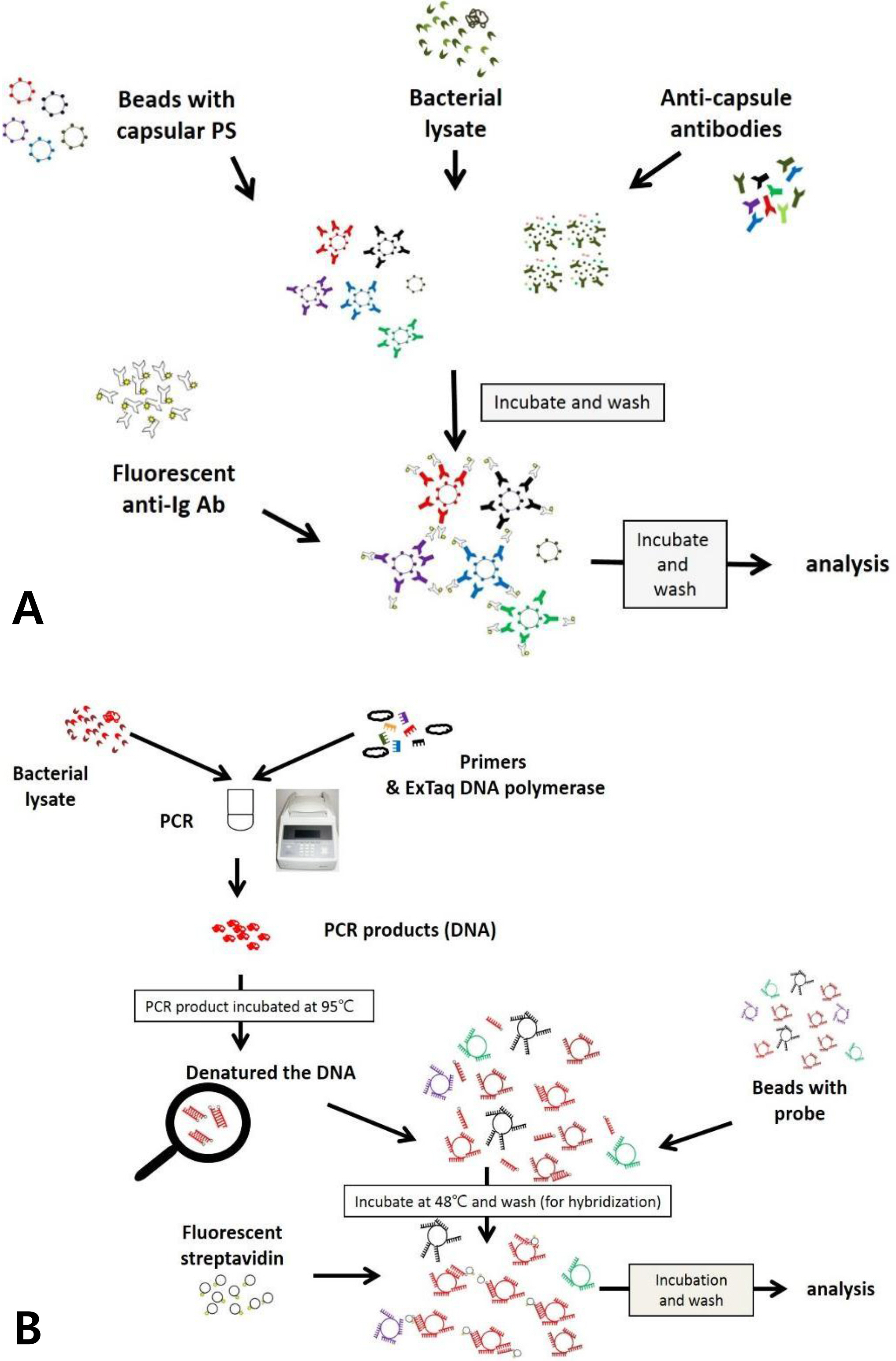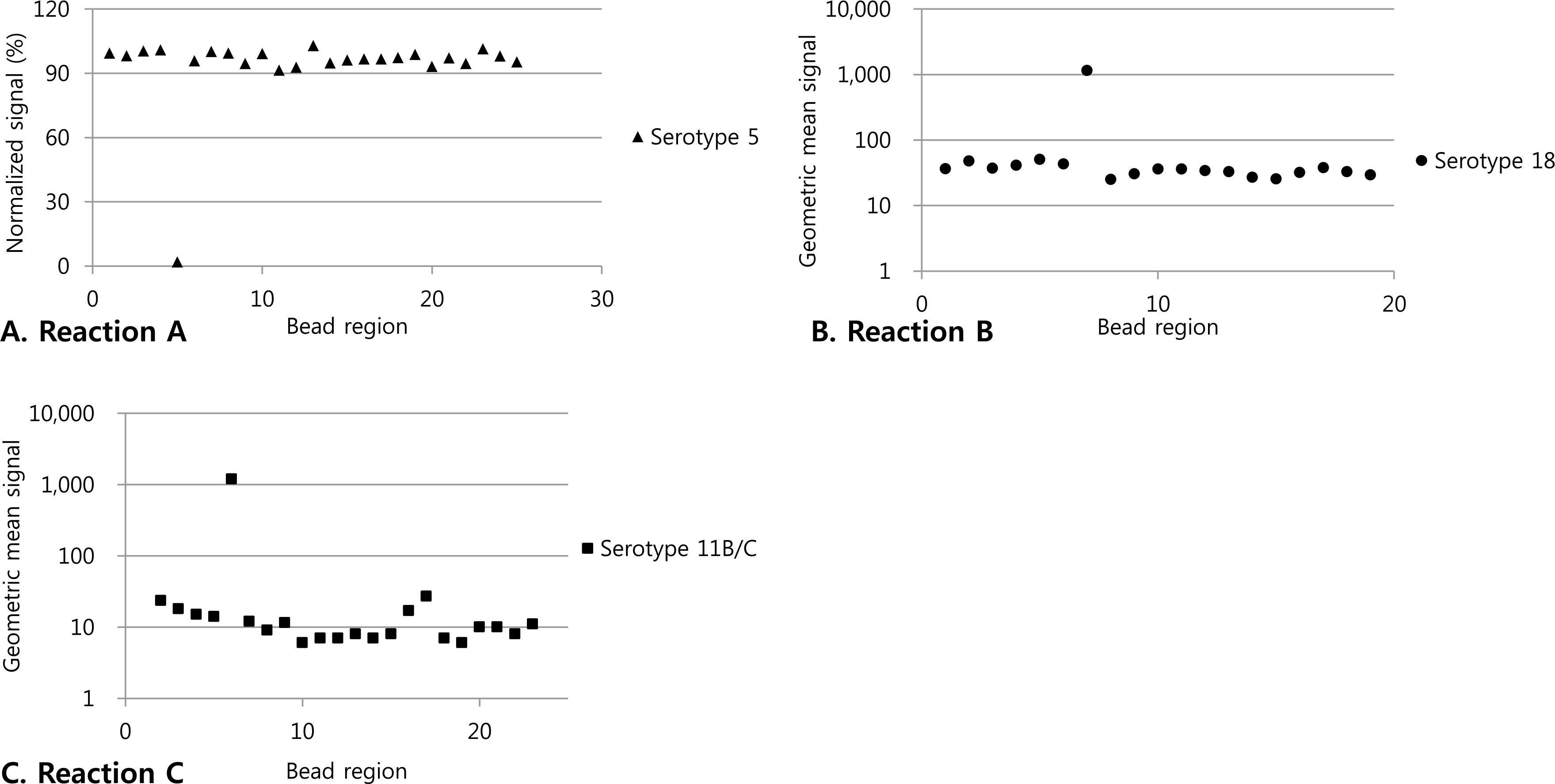Pediatr Infect Vaccine.
2015 Aug;22(2):97-105. 10.14776/piv.2015.22.2.97.
Establishment and Application of a Multibead Serotyping Assay for Pneumococci in Korea
- Affiliations
-
- 1Department of Pediatrics, Ewha Womans University School of Medicine, Seoul, Korea. kaykim@ewha.ac.kr
- 2Center for Vaccine Evaluation and Study, Ewha Medical Research Institute, Ewha Womans University School of Medicine, Seoul, Korea.
- 3Department of Laboratory Medicine, Ewha Womans University School of Medicine, Seoul, Korea.
- KMID: 2465254
- DOI: http://doi.org/10.14776/piv.2015.22.2.97
Abstract
- PURPOSE
Serotyping pneumococcal isolates is important to monitor efficacy of pneumococcal vaccines. Because of difficulties of typing pnueumocci, a multiplex bead-based (multibead) serotyping assay was recently introduced. The aim of this study is to establish a new multibead serotyping assay and to apply this method to analyze clinical isolates of pneumococci in Korea.
METHODS
To establish the multibead serotyping assay, six key reagents were transferred from University of Alabama at Birmingham (UAB) to Ewha Center for Vaccine Evaluation and Study (ECVES): bead set coated with polysaccharide and monoclonal antibody pool were used in one multiplex inhibition-type immunoassay and 2 bead sets coated DNA probe and 2 primer pools were used in two multiplex PCR-based assays. After multibead serotyping assay was set up, 75 test samples of pneumococci were analyzed whether ECVES is able to identify serotype correctly. After confirming the performance, serotyping assay was applied to identify serotypes of 528 clinical isolates of pneumococci collected from 3 different hospitals.
RESULTS
After establishment of the multibead pneumococcal serotyping assay system at ECVES, 75 test samples were analyzed. There was no discrepancy of serotypes of 75 test samples between the results assigned at UAB and those at ECVES. The serotypes of 528 pneumococci isolated from patients or healthy subjects were determined in 94.3% of isolates (498/528).
CONCLUSIONS
The multibead pneumococcal serotyping assay can be successfully established in Korea. With this method, surveillance of serotypes of pneumococci isolated from patients as well as healthy subjects could be studied.
Keyword
MeSH Terms
Figure
Reference
-
1. Bentley SD, Aanensen DM, Mavroidi A, Saunders D, Rabbi—nowitsch E, Collins M, et al. Genetic analysis of the capsular biosynthetic locus from all 90 pneumococcal serotypes. PLoS Genet. 2006; 2:e31.
Article2. CaliX JJ, Nahm MH. A new pneumococcal serotype, 11E, has a variably inactivated wcjE gene. J Infect Dis. 2010; 202:29–38.3. Park 1H. Geno KA, Yu J, Oliver MB, Kim KH, Nahm MH. Genetic, biochemical, and serological characterization of a new pneumococcal serotype, 6H, and generation of a pneu—mococcal strain producing three different capsular repeat units. Clin Vaccine Immunol. 2015; 22:313–8.4. Hicks LA, Harrison LH, Flannery B, Hadler JL, Schaffner W, Craig AS, et al. Incidence of pneumococcal disease due to non—pneumococcal conjugate vaccine (PCV7) serotypes in the United States during the era of widespread PCV7 vacci—nation, 1998—2004. J Infect Dis. 2007; 196:1346–54.
Article5. Lund E. Laboratory diagnosis of pneumococcus infections. Bull World Health Organ. 1960; 23:5–13.6. Slotved HC, Kaltoft M, Skovsted IC, Kerrn MB, Espersen F. Simple, rapid latex agglutination test for serotyping of pneu—mococci (Pneumotest—Latex). J Clin Microbiol. 2004; 42:2518–22.
Article7. Pai R, Gertz RE, Beall B. Sequential multiplex PCR approach for determining capsular serotypes of Streptococcus pneu— monjae isolates. J Clin Microbiol. 2006; 44:124–31.8. Magomani V, Wolter N, Tempia S, du Plessis M, de Gouveia L, von Gottberg A. Challenges of using molecular serotyping for surveillance of pneumococcal disease. J Clin Microbiol. 2014; 52:3271–6.
Article9. Yu J, Lin J, Benjamin WH Jr, Waites KB, Lee CH, Nahm MH. Rapid multiplex assay for serotyping pneumococci with monoclonal and polyclonal antibodies. J Clin Microbiol. 2005; 43:156–62.
Article10. Yu J, Lin J, Kim KH, Benjamin WH Jr, Nahm MH. Develop—ment of an automated and multiplexed serotyping assay for Streptococcus pneumoniae. Clin Vaccine Immunol. 2011; 18:1900–7.
Article11. Yu j. Carvalho Mda G, Beall B, Nahm MH. A rapid pneu—mococcal serotyping system based on monoclonal antibodies and PCR. J Med Micr0b101. 2008; 57:171–8.12. Turner P, Turner C, Iankhot A, Phakaudom K, Nosten F, Goldblatt D. Field evaluation of culture plus latex sweep serotyping for detection of multiple pneumococcal serotype colonisation in infants and young children. PLoS One. 2013. 81667933.
Article13. Siira L, Kaijalainen T, Lambertsen L, Nahm MH, Toropainen M, Virolainen A. From Quellung t0 multiplex PCR, and back when needed, in pneumococcal serotyping. j Clin Microbiol. 2012; 50:2727–31.14. Dhoubhadel BG, Yasunami M, Yoshida LM, Thi HAN, Thi THV, Thi TAN, et al. A novel high—throughput method for molecular serotyping and serotype—specific quantification of Streptococcus pneumoniae using a nanofluidic real—time PCR system. J Med Microbiol. 2014; 63:528–39.15. Findlow H, Laher G, Balmer P, Broughton C, Carrol ED, Borrow R. Competitive inhibition flow analysis assay for the non—culture—based detection and serotyping of pneumococcal capsular polysaccharide. Clin Vaccine Immunol. 2009; 16:222–9.16. Cho EY, Lee H, Choi EH, Kim Yj, Eun BW, Cho YK, et al. Serotype distribution and antibiotic resistance of Streptococ— cus pneumoniae isolated from invasive infections after optional use of the 7-Valent conjugate vaccine in Korea, 2006—2010. Diagn Microbiol Infect Dis. 2014; 78:481–6.17. Hathaway LJ, Stutzmann Meier P, Battig P, Aebi S, Muhle-mann K. A homologue of aliB is found in the capsule region of nonencapsulated Streptococcus pneumoniae. J Bacteriol. 2004; 186:3721–9.18. Nagai K, Shibasaki Y, Hasegawa K, Davies TA, Jacobs MR, Ubukata K, et al. Evaluation of PCR primers to screen for Streptococcus pneumoniae isolates and βlactam resistance, and to detect common macrolide resistance determinants. J Antimicrob Chemother. 2001; 48:915–8.19. Kawaguchiya M, Urushibara N, Ghosh S, Kuwahara O, Morimoto S, Ito M, et al. Serotype distribution and suscepti—bility to penicillin and erythromycin among noninvasive or colonization isolates of Streptococcus pneumoniae in northern Japan: A cross—sectional study in the pre-PCV7 routine immunization period. Microb Drug Resist. 2014; 20:456–65.20. Park IH, Pritchard DG, Cartee R, Brandao A, Brandileone MC, Nahm MH. Discovery of a new capsular serotype (6C) within serogroup 6 of Streptococcus pneumoniae. J Clin Microbiol. 2007; 45:1225–33.
- Full Text Links
- Actions
-
Cited
- CITED
-
- Close
- Share
- Similar articles
-
- A study of serotyping of Streptococcus pneumoniae by multibead assay
- Comparison of Multiplex Latex Bead Flow Cytometric Analysis and Quellung Analysis in Serotyping Pneumococci
- Nasopharyngeal Carriage Rate and Serotypes of Streptococcus pneumoniae and Antimicrobial Susceptibility in Healthy Korean Children Younger than 5 Years Old: Focus on Influence of Pneumococcal Conjugate Vaccination
- Epidemiological Studies of Yersinia pseudotuberculosis Infection by Plasmid DNA Profile Assay
- Functional Immunity to Cross-Reactive Serotype 6A Induced by Serotype 6B in Pneumococcal Polysaccharide Vaccine



